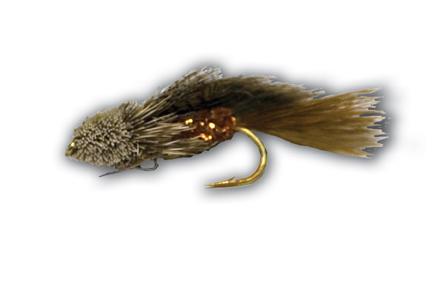Mad River Sculpin
For the fisherman, fall is a transition from some of the best dry-fly fishing of the year to some of the best streamer fishing of the year. Typically we think of big, gaudy, nasty streamers for the fall, and make no mistake: I have those in my fly box. But there are those days when fish don’t want to chase a fly a country mile and love nothing more than sitting in their little holes and munching on sculpins and other assorted baitfish.
That’s where this little beauty comes in. It isn’t your “stripper” variety; this is meant for dead-drifting below an indicator with some split shot. The little touches on this fly set it apart from your garden-variety deer hair sculpin that the fish see a lot of. I’ve landed lots of fish on the Madison, Gallatin, Yellowstone and all of their tributaries on this pattern. Just add a few split shot off the front for turbid water, or leave it completely naked on shallower stretches like the Lower Madison. Either way, it’s a great pattern in the fall for those days when the fish won't chase down your bunny monstrosity!
Step 1: I like a little weight to counteract the massive amount of packed deer hair on the head of this sculpin. So prelead your shank (typically I like .025 or .030 to fatten up the body and keep the fly from floating). Start the lead right in front of the back bend. Now wrap forward 3/4 of the hook and break off.
Step 2: Secure your thread to the hook and coat the hook shank back to the bend of the hook. This is where you tie in your marabou tail. I like to keep my tail fairly short on this pattern; typically a half-shank length of marabou is plenty. Secure by taking the thread up just past the halfway point on the shank.
Step 3: Secure wire or ribbing material at the back end by the marabou tie in; you're going to use this to tie your strip of squirrel in Matuka style and secure your hackle. Leave this hanging off the back for now.
Step 4: Attach the chenille. If you're getting a fat backend (on the fly), strip off the chenille until you have exposed thread strands and tie these in instead of the bulky chenille. Next, wrap that chenille forward about 3/4 of the shank of the hook. You still have to fit a big fat deer-hair head on this pattern, but a lot of the collar is going to extend past your chenille.
Step 5: Tie in your hackle at the ¾ point where you left off your chenille, and palmer this back to the tail, tie in, and secure with one wrap of wire.
Step 6: Your squirrel strip adds a little flair and movement to this fly. You are going to tie this in Matuka style, so be prepared with a bodkin and some saliva so you can separate out the hair, pass your wire through it, and secure it to the hook. For any questions on this, come see me or consult your local fly-tying friends. They may charge you a beer, though.
Step 7: Add the peck fins, which can be pheasant, partridge, mallard flank, or whatever your taste is (or whatever you have the most of from hunting season).
Step 8: Spin a nice big collar of deer hair for the head. For help on spinning hair, consult those fly-tying buddies and come prepared with a six-pack and vacuum.
Step 9: Stack the hair nice and tight until you get to the hook eye. Having a full head is important for action on this pattern.
Step 10: Shape the fly with a good pair of scissors, trimming the bottom nice and flush (a razor blade is nice for shaving deer hair down, but requires some dexterity). Be careful not to trim your collar on the top though, that’s for looks!
If you have a finished product that looks something like the picture, congratulations! If you don’t, offer your fly-tying buddies a few more beers and see if they will help you perfect it. But remember, it doesn’t have to be pretty to catch fish.
Ingredients:
Hook: Dai Riki 730, sizes 4-8
Thread: Danville Flymaster Plus, color to match sculpin color
Ribbing: Brassie wire, color to match sculpin color
Tail: Marabou, match sculpin color
Body: Variegated Tinsel chenille, match sculpin color
Hackle: Strung rooster saddle, match sculpin color
Dorsal Fin: Pine Squirrel strip, match sculpin color
Pectoral Fins: Hun partridge, mallard flank, pheasant flank
Head: Natural deer hair or matching sculpin color
Other Required Materials: Razorblade, beer for friends’ help, vacuum
Kris Kumlien is the general manager of Montana Troutfitters in Bozeman. His father, Dave, opened the shop in 1978.






